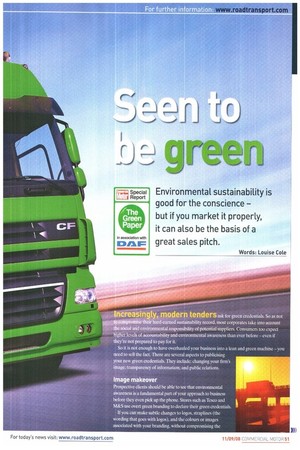Environmental sustainability is good for the conscience but if you
Page 51

Page 52

Page 55

If you've noticed an error in this article please click here to report it so we can fix it.
market it properly, it can also be the basis of a great sales pitch.
Words: Louise Cote
tncreasingly, modern tenders ask for green credentials So as not to compromise their hard-earned sustainabilitv record, most corporates take into account the social and environmental responsibility of potential suppliers. Consumers too expect higher levels of accountability and environmental awareness than ever before — even if they're not prepared to pay for it.
So it is not enough to have overhauled your business into a lean and green machine — you need to sell the fact, There are several aspects to publicising your new green credentials. They include: changing your firms image: transparency of information: and public relations.
Image makeover
Prospective clients should he able to see that environmental awareness is a fundamental part of your approach to business before they even pick up the. phone. Stores such as Tesco and M&S use overt geen branding to declare their green credentials.
if you can make subtle changes to logos, straplines (the wording that goes with logos), and the colours or images associated with your branding, without compromising the brand recognition you have achieved, it's worth doing so.
The idea is to incorporate positive natural and environmental themes into your existing brand. For example, "A&N Transport delivering for you and the environment" and "A&N Transport delivering today, protecting tomorrow" are examples of messages that clearly associate your core business with your new environmental status.
It may be that you want to leave your brand and livery untouched for sound commercial and financial reasons. In that case, look at introducing a separate small logo to be incorporated into liveries, letterheads. uniforms and business cards. This could be a simple statement, such as: • "I'm a clean, green truck"; • -Driving environmental progress • "Working to protect the environment".
If there is space, include: "For more details, see www.a&ntransport.com/green." This invites people to explore the role of sustainability in modern transport. Make sure you can back up any claims you make.
If your sustainability campaign is well underway and you have results to boast about, hold an open day. Invite existing customers, prospective customers, local politicians, the local chamber of commerce and, of course, the local and trade press. Give a short presentation about your green journey and results.
Its useful to include a wider perspective on the improvements in freight generally, as this will have more impact with journalists and local politicians, but you can do it without stealing your own thunder. Perhaps take the line of: "Road transport has come a long way and now we're taking it even further."
Statistics on the huge efficiency and emissions improvements made in the freight industry can be found at http://tinyurl.com/5bqtn86 and in a booklet produced by Daf called Dal' and the Environment. Your vehicle manufacturer of choice should also be able to give you some stats about their vehicles.
Take questions; encourage customers to participate. Offer a logo for your customers to use in their own marketing to show that their transport is environmentally sustainable. Perhaps suggest a partnership between you, your customers and the local council or chamber of commerce to encourage green initiatives. This can help you all to achieve valuable press coverage, develop higher profiles within the business community and make your names synonymous with environmental progress.
Prove it
You won't change your company image if you can't hack up your claims. You need to be able to publish in detail the great improvements your company has made, ideally benchmarked against the industry average.
By all means pick those statistics that work best for you. If customer demands make it impossible to reduce empty running, but you have Euro-5 trucks, then concentrate on emissions. It may be useful to publish your original green audit and show the improvements you have made since then, although you may decide that a negative audit could produce negative PR.
Make sure you have an environmental policy published in hard format and on your website. Include a section on environmental progress in every annual report. You could even invite members of staff to start a blog on your site about their attempts to be green at home and at work.
Quantify the information wherever possible, not just with figures, but with comparisons that people can relate to for example, calculate your carbon saving in kilogrammes or tonnes, but then suggest how many trees would have needed to be planted to offset that amount You can also show how many tonnes of goods your trucks deliver for the amount of carbon used in one tlight to New York. It's about placing road transport and your trucks in particular on the right side of the green debate.
Public relations
As the old saying goes: we all do PR, just some of us choose to manage it. And with transport being so competitive, it is worth considering anything that might differentiate you from your rivals.
Professional PR can become expensive, so the decision to take on an agency or professional should always be subject to a cost-benefit analysis. It is hard to predict the results of PR and impossible to guarantee them, but there are clear guidelines that will enhance any PR campaign.
First, decide on clear objectives. Be clear who you want to reach. PR is essentially a conversation between you and whoever you want to hear your message. Trade magazines, such as CM and sister titles Motor Transport and Truck di Driver (not forgetting roadtransport.com) are good for communicating with the rest of the industry. Existing customers can be reached through an in-house newsletter, which you can send out or put up on your site.












































































































































































